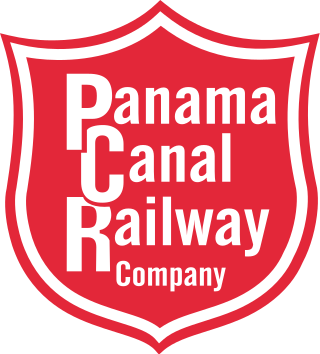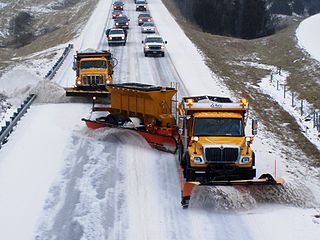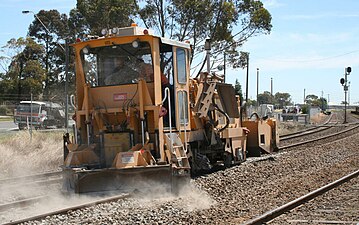
A railroad car, railcar, railway wagon, railway carriage, railway truck, railwagon, railcarriage or railtruck, also called a train car, train wagon, train carriage or train truck, is a vehicle used for the carrying of cargo or passengers on a rail transport network. Such cars, when coupled together and hauled by one or more locomotives, form a train. Alternatively, some passenger cars are self-propelled in which case they may be either single railcars or make up multiple units.

A railway track or railroad track, also known as a train track or permanent way, is the structure on a railway or railroad consisting of the rails, fasteners, railroad ties and ballast, plus the underlying subgrade. It enables trains to move by providing a dependable surface for their wheels to roll upon. Early tracks were constructed with wooden or cast iron rails, and wooden or stone sleepers; since the 1870s, rails have almost universally been made from steel.

The Panama Canal Railway is a railway line linking the Atlantic Ocean to the Pacific Ocean in Central America. The route stretches 47.6 miles (76.6 km) across the Isthmus of Panama from Colón (Atlantic) to Balboa. Because of the difficult physical conditions of the route and state of technology, the construction was renowned as an international engineering achievement, one that cost US$8 million and the lives of an estimated 5,000 to 10,000 workers. Opened in 1855, the railway preceded the Panama Canal by half a century; the railway was vital in assisting the construction of the canal in the early 1900s. With the opening of the canal, the railroad's route was changed as a result of the creation of Gatun Lake, which flooded part of the original route. Following World War II, the railroad's importance declined and much of it fell into a state of neglect until 1998, when a project to rebuild the railroad to haul intermodal traffic began; the new railroad opened in 2001.

A railroad tie, crosstie, railway tie or railway sleeper is a rectangular support for the rails in railroad tracks. Generally laid perpendicular to the rails, ties transfer loads to the track ballast and subgrade, hold the rails upright and keep them spaced to the correct gauge.

A rotary snowplow or rotary snowplough is a piece of railroad snow removal equipment with a large circular set of blades on its front end that rotate to cut through the snow on the track ahead of it. The precursor to the rotary snowplow was the wedge snowplow.

Maintenance of way refers to the maintenance, construction, and improvement of rail infrastructure, including tracks, ballast, grade, and lineside infrastructure such as signals and signs.

A snowplow is a device intended for mounting on a vehicle, used for removing snow and ice from outdoor surfaces, typically those serving transportation purposes. Although this term is often used to refer to vehicles mounting such devices, more accurately they are known as winter service vehicles, especially in areas that regularly receive large amounts of snow every year, or in specific environments such as airfields. In other cases, pickup trucks and front end loaders are outfitted with attachments to fulfill this purpose. Some regions that do not frequently see snow may use graders to remove compacted snow and ice off the streets. Snowplows can also be mounted on rail cars or locomotives to clear railway tracks.

Track ballast is the material which forms the trackbed upon which railroad ties are laid. It is packed between, below, and around the ties. It is used to bear the compression load of the railroad ties, rails, and rolling stock; to facilitate drainage; and keep down vegetation that can compromise the integrity of the combined track structure. Ballast also physically holds the track in place as the trains roll over it. Not all types of railway tracks use ballast.

The Monson Railroad was a 2 ft narrow gauge railway, which operated between Monson Junction on the Bangor and Aroostook Railroad and Monson, Maine. The primary purpose of this railroad was to serve several slate mines and finishing houses in Monson. According to the Scientific American of 17 May 1890, it was the smallest railroad in the United States.
H and H Engineering Construction, Inc. is a railroad contractor based out of Stockton, California. H & H is incorporated in the State of California and has been in operation since October 1985.

The M9 armored combat earthmover (ACE) is a highly mobile armored tracked vehicle that provides combat engineer support to frontline forces. Fielded by the United States Army, its tasks include eliminating enemy obstacles, maintenance and repair of roads and supply routes, and construction of fighting positions.

A tamping machine or ballast tamper, informally simply a tamper, is a self-propelled, rail-mounted machine used to pack the track ballast under railway tracks to make the tracks and roadbed more durable and level. Prior to the introduction of mechanical tampers, this task was done by manual labour with the help of beaters. As well as being faster, more accurate, more efficient and less labour-intensive, tamping machines are essential for the use of concrete sleepers since they are too heavy to be lifted by hand.

A work train is one or more rail cars intended for internal non-revenue use by the railroad's operator. Work trains serve functions such as track maintenance, maintenance of way, revenue collection, system cleanup and waste removal, heavy duty hauling, and crew member transport.

A spreader is a type of maintenance equipment designed to spread or shape ballast profiles. The spreader spreads gravel along the railroad ties. The various ploughs, wings and blades of specific spreaders allow them to remove snow, build banks, clean and dig ditches, evenly distribute gravel, as well as trim embankments of brush along the side of the track. Spreaders quickly proved themselves as an extremely economical tool for maintaining trackside drainage ditches and spreading fill dumped beside the track.

Loram Maintenance of Way, Inc. is a railroad maintenance equipment and services provider. Loram provides track maintenance services to freight, passenger, and transit railroads worldwide, as well as sells and leases equipment which performs these functions.

A track renewal train is a work train that consists of many units of machinery and materials required for track renewal projects.
Etihad Rail DB was a heavy-rail Operations & Maintenance (O&M) service provider in the UAE. The company was set up in 2013 as a joint venture between Etihad Rail (51%), the developer of the UAE's national railway network and Deutsche Bahn (DB) (49%), Europe's largest railway operator and infrastructure owner. Etihad Rail DB was responsible for the operations and maintenance of Stage One of the UAE's national railway network for Etihad Rail’s primary customer, the Abu Dhabi National Oil Company (ADNOC). Etihad Rail DB concluded an Operations & Maintenance (O&M) Agreement with Etihad Rail in August 2013.

A Tie exchanger is a self-propelled railroad maintenance of way vehicle that removes old railroad ties from tracks and inserts new ones. By using mechanical and hydraulic force, a tie extractor/inserter can replace ties much faster and with more precision than is possible by hand.

Nordco, Inc. is an American manufacturer of railroad maintenance of way and inspection equipment, based in Oak Creek, Wisconsin. Founded in 1926, it has been a subsidiary of Wabtec since 2021. The company is one of the top manufacturers of railroad maintenance equipment in North America.






















